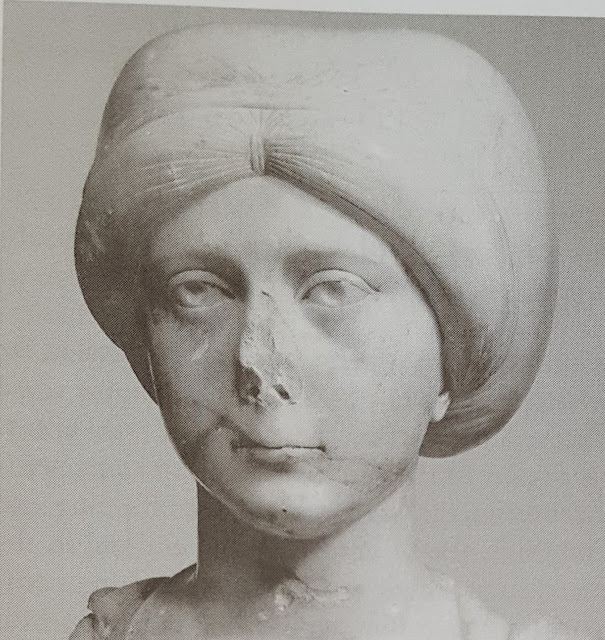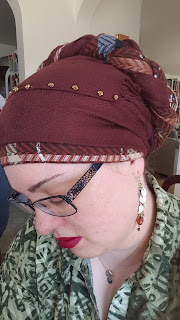(Topic: Historical Fashion)
Hi Friends!
A friend of mine recently started wearing headwraps, and I ended up trying them too, after someone suggested they may help with my anxiety (mixed results: once they are on, I at least perceived a certain amount of comfort from them, but getting them on sometimes was more stressful…).
Well, with my interests, it seems only natural that I should explore some of the historical uses of headwraps and head coverings! They are all over the place, in many cultures, eras, religious traditions, and even high fashion! My knowledge of historical fashion is mostly limited to Europe, which for much of history has been Christian, though, so most of my examples will be from that demographic. However, many many other times, religions, and places have their own twist (ha!) on head coverings, too, so do some digging! You’ll find lots of beautiful people with beautiful head wear!
To be clear, I’m going to focus on women, and on head wear that was for the whole day (not just when going out, like a hat or bonnet, or for specific occasions, like a wedding veil). I will be focused on Europe but will include a few other regions, and focused on more recent eras from the middle ages to nearly now, but will throw in a few older examples too.
Note: there are many eras, regions, and cultures in which having fancy hair was the thing, even in “ancient” cultures, and many where it was usual to cover the hair. There are also many where men and women did not wear head coverings, and many where both did. It varies widely. Even today, it varies widely, even if you are only looking at the western world: In the US, some observant Jews wear head coverings, as do some segments of African American society, as well as Christian nuns, the Amish and some Mennonites, and some conservative Christians cover their hair with a pinned on piece of lace or a small kerchief. However, we largely no longer always cover our heads when leaving the house (which used to be what everyone did). Since the 1960s, it’s no longer de regure to wear a hat when away from home.
 |
| Fig. 1, from Source B, pg 41. “Head-dress of Shub-ad (Pu-abi), Queen of Ur”. Ancient Mesopotamia (Sumerian), about 4th Millennium BC. |
 |
Fig. 2, from Source A, pg 172.
Ancient Mesopotamia (Sumerian), about 4th Millennium BC. |
 |
| Fig. 3, from Source A, pg 80. “Marble statuette of a goddess. Late Minoan” 1580-1450 BC |
 |
| Fig. 4, from Source A, pg 97. “Woman’s head-dress from Thebes. Eighteenth Dynasty” 1580-1320 BC Egypt |
 |
| Fig. 5, from Source F, pg 66. Etruscan, with shawl. 800-200 BC |
 |
| Fig. 6, from Source A, pg 112. Etruscan, 700-575 BC |
 |
| Fig. 7, from Source F, pg 75. Statue from 1st Century. Palla. |
 |
| Fig. 8, from Source F, pg 93. Byzantine, late 5th Century. |
 |
| Fig. 9, from Source A, pg 177. “Countess Uta, Naumberg Cathedral” 13th Century |
 |
| Fig. 10, from Source F, pg 108. Fillet and barbette, and coif. Ca. 1225-1250 |
 |
| Bonus picture: me wearing a fillet and barbette! No coif (cap) underneath, though. Sometimes a veil is worn on top, too. |
 |
| Fig. 11, from Source F, pg 130. 14th Century |
 |
| Fig. 12, from Source A, pg 201. 15th Century |
 |
| Fig. 13, from Source F, pg 158. Early 15th Century. Peasant. |
 |
| Fig. 14, from Source A, pg 208. From Roger van der Weyden’s “Portrait of a Woman”, painted 1433 |
 |
| Fig. 15, from Source A, pg 190. From Jan van Eyck’s “Jan Arnolfini and his Wife”, painted 1435. Frilled/stacked veils. |
 |
| Fig. 15, from Source F, pg 174. France, ca. 1500 “coif with lappets” |
 |
| Fig. 16, from Source F, pg 163. Early 16th century. Turban-like head-dress |
 |
| Fig. 17, from Source F, pg 182. Flemish, ca. 1535. Coif, small hood. |
 |
| Fig. 18, from Source F, pg 182. Late 16th, by Anthonis Mor von Dashorst, “Portrait of Margaretta of Parma”. Coif. |
 |
| Fig. 19, from Source A, pg 289. From J.D. de Saint-Jean’s “Peasant Woman from the Paris Region”, late 17th Century |
 |
| Fig. 20, from Source F, color section. “Mrs. Elizabeth Freake and Baby Mary” unknown artist, Massachusetts settlers. ca 1674 |
 |
| Fig. 21, from Source F, pg 230. late 18th century. Cap, from the back. |
 |
| Fig. 22, from Source A, pg 334. “Formal toilette in muslin, toupée head-dress, 1797″ |
 |
| Fig. 23, from Source A, pg 371. Carl Begas’ “The Begas Family” painted 1821. Note only the older/married woman wears a cap. |
 |
| Fig. 24, from Source E, pg 12. ca. 1842, Sophia Jones Ireland, age 69 |
 |
| Fig. 25, from Source D, pg 54. Ca. 1847. Daycap. |
 |
| Fig. 26, from Source C, pg 11. 1860s. Velvet ribbon hairnet. |
 |
| Fig. 27, from Source C, pg 10. Fine net, worn over dressed hair. 1860s. |
 |
| Fig. 28, from Source C, pg 15. Older hairstyle on an older woman. Daycap with large lappets/ties. 1860s. |
Want to learn more? AWESOME! First off, your local public library is a great place to start. If they don’t have historical fashion books, they can probably get them by borrowing them from another library for you, called “interlibrary loan” (there are several systems they may use to do that… just ask a librarian for help if you are not familiar with how to do it). You can start off with overviews of history, but I highly recommend you look for one that has photos of original artifacts, museum pieces, and paintings, rather than one that uses drawings and tracings, since you can’t see what they are based on. Once you find an era that you are interested in, find books specifically about fashion in that era, since they will be much more in-depth. And most important: have fun!
Here are the sources I used for this post:
Source A:
Barber, Elizabeth Wayland. Women’s Work: The First 20,000 Years: Women, Cloth, and Society in Early Times. W. W. Norton & Company, 1994.
Source B:
Boucher, François. 20,000 Years of Fashion: The History of Costume and Personal Adornment: Expanded Edition. Harry N. Abrams, Inc., Publishers, 1987.
Source C:
Leisch, Juanita. Who Wore What? Women’s Wear 1861-1865. Thomas Publications, 1995.
Source D:
Severa, Joan L. Dressed for the Photographer: Ordinary Americans & Fashion, 1840-1900. Kent State University Press, 1995.
Source E:
Severa, Joan L. My Likeness Taken: Daguerreian Portraits in America. Kent State University Press, 2005.
Source F:
Tortora, Phyllis G. and Keith Eubank. Survey of Historic Costume: A History of Western Dress, 4th Ed. Fairchild Publications, Inc. 2005.
Yours,
Sarah
To subscribe, find the “subscribe by email” note in the left column and enter your email there. Posts will be emailed directly to you whenever I post them!
Resource list: Visit my spreadsheet at www.tinyurl.com/infantloss





























